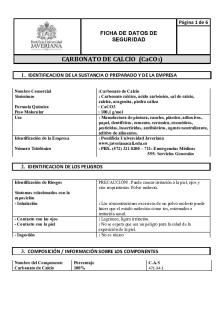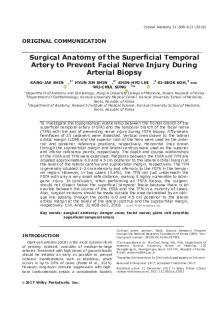Ca CO3 HCl - Lecture notes 1 PDF

| Title | Ca CO3 HCl - Lecture notes 1 |
|---|---|
| Author | Marilyn Michael |
| Course | Adv Analytical Chem |
| Institution | Indiana University - Purdue University Indianapolis |
| Pages | 2 |
| File Size | 54.6 KB |
| File Type | |
| Total Downloads | 70 |
| Total Views | 176 |
Summary
The last factor, the presence of a catalyst was also tested by preparing two test tubes. In each of the two test tubes, 5 ml of 3% hydrogen peroxide (H2O2) was placed with about 1 g of Rochelle salt or sodium potassium tartrate. One test tube was then heated gently while a pinch of cobalt (II) chlor...
Description
Year 11 Chemistry Practical Investigation
NAME______________________
Rate of Reaction of HCl with CaCO 3 Aim: To investigate how the rate of a chemical reaction changes over time by observing a reaction between hydrochloric acid and calcium carbonate. 2HCl + CaCO3 H2O + CaCl 2 + CO 2
Equipment:
1g calcium carbonate, powdered 50 mL HCl solution, 0.1 mol L-1 conical flask 100 mL beaker electronic balance cotton wool
Procedure: 1. Pull at a ball of cotton wool until it is large enough to rest in the mouth of the conical flask without falling in. 2. Add 1g CaCO 3 powder to a conical flask. Leave the conical flask on the electronic balance. 3. Measure 50 mL of 0.1 mol L -1 HCl into a 100 mL beaker. 4. Pour the HCl to the conical flask and place the cotton wool in the mouth of the conical flask. Immediately record the weight and start the stopwatch. 5. Whenever you are not measuring the weight of the flask, swirl it to unsure the reactants are evenly mixing together. 6. Record the weight every 30 seconds until there is no longer any CaCO3 visible in the conical flask. cotton wool
conical flask electronic balance
Results: Make a copy of this table to record results. This table does not have enough rows. Time (seconds)
Mass of flask (g)
Analysis and Evaluation: 1. Plot a graph of the mass of the flask against the time of reaction. 2. State whether the rate of reaction is faster at the beginning or end of the reaction. Describe how the graph shows this. 3. Explain, in terms of particle collisions, why the rate of reaction changes over the course of the reaction. 4. Using different colours, draw lines on the graph to show the expected results if the experiment was repeated and one change was made each time: (a) Half the amount of CaCO 3 was used (b) The CaCO 3 was in lumps instead of powder (c) The acid had been preheated to 50°C (d) 50 mL of water had been added to the acid prior to tipping into the flask 5. Explain one possible source of random error in this experiment, and describe evidence for it in the results. 6. Suggest one possible improvement to the experiment that would improve the accuracy of the results. Explain why it would improve accuracy.
Stoichiometric Analysis (Bonus): The amount of CO 2 released is an indication of the amount of CaCO3 consumed in the reaction. 1. Use the first and last points of data in your results to calculate the mass lost from the flask. 2. This mass is CO 2 gas. Calculate the number of moles of CO2 released. 3. Use the balanced equation given on the previous page to determine the number of moles of CaCO3 used up during the reaction. 4. Hence calculate the mass of CaCO3 that reacted. 5. Compare the calculated mass to the mass of CaCO 3 originally measured. Suggest reasons for any differences....
Similar Free PDFs

Ca CO3 HCl - Lecture notes 1
- 2 Pages

Fichas de Seguridad Ca CO3
- 6 Pages

CS8491 CA - Lecture notes 5
- 2 Pages

Ca - Notes
- 10 Pages

Ca - notes
- 6 Pages

Chua vs CA - Lecture notes Sales
- 1 Pages

Hydrochloric acid - notes on HCl
- 1 Pages

Lecture notes, lecture 1
- 9 Pages

Lecture notes, lecture 1
- 4 Pages

Lecture-1-notes - lecture
- 1 Pages

Lecture notes- Lecture 1
- 20 Pages

Lecture notes, lecture 1
- 4 Pages

Lecture-1 - Lecture notes 1
- 6 Pages

Lecture notes, lecture 1
- 9 Pages

1 - Lecture notes 1
- 11 Pages
Popular Institutions
- Tinajero National High School - Annex
- Politeknik Caltex Riau
- Yokohama City University
- SGT University
- University of Al-Qadisiyah
- Divine Word College of Vigan
- Techniek College Rotterdam
- Universidade de Santiago
- Universiti Teknologi MARA Cawangan Johor Kampus Pasir Gudang
- Poltekkes Kemenkes Yogyakarta
- Baguio City National High School
- Colegio san marcos
- preparatoria uno
- Centro de Bachillerato Tecnológico Industrial y de Servicios No. 107
- Dalian Maritime University
- Quang Trung Secondary School
- Colegio Tecnológico en Informática
- Corporación Regional de Educación Superior
- Grupo CEDVA
- Dar Al Uloom University
- Centro de Estudios Preuniversitarios de la Universidad Nacional de Ingeniería
- 上智大学
- Aakash International School, Nuna Majara
- San Felipe Neri Catholic School
- Kang Chiao International School - New Taipei City
- Misamis Occidental National High School
- Institución Educativa Escuela Normal Juan Ladrilleros
- Kolehiyo ng Pantukan
- Batanes State College
- Instituto Continental
- Sekolah Menengah Kejuruan Kesehatan Kaltara (Tarakan)
- Colegio de La Inmaculada Concepcion - Cebu
